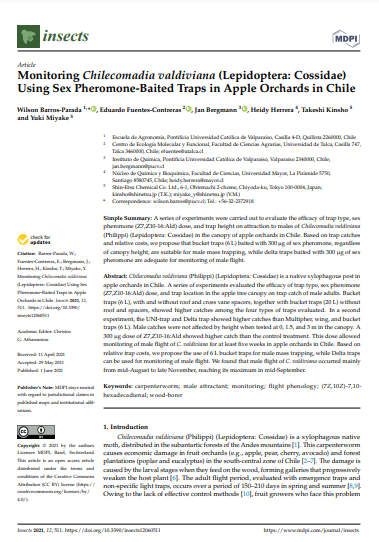Monitoring Chilecomadia valdiviana (Lepidoptera: Cossidae) Using Sex Pheromone-Baited Traps in Apple Orchards in Chile

Fecha
2021-07-07Autor
Barros-Parada, Wilson
Fuentes-Contreras, Eduardo
Bergmann, Jan; Kinsho
Takeshi; Miyake, Yuki
Herrera, Heidy [Univ Mayor, Fac Ciencias, Nucleo Quim & Bioquim, Chile]
Ubicación geográfica
Notas
HERRAMIENTAS
Acceda a títulos restringidos
¿Cómo descargar?Resumen
Simple Summary A series of experiments were carried out to evaluate the efficacy of trap type, sex pheromone (Z7,Z10-16:Ald) dose, and trap height on attraction to males of Chilecomadia valdiviana (Philippi) (Lepidoptera: Cossidae) in the canopy of apple orchards in Chile. Based on trap catches and relative costs, we propose that bucket traps (6 L) baited with 300 mu g of sex pheromone, regardless of canopy height, are suitable for male mass trapping, while delta traps baited with 300 mu g of sex pheromone are adequate for monitoring of male flight. Chilecomadia valdiviana (Philippi) (Lepidoptera: Cossidae) is a native xylophagous pest in apple orchards in Chile. A series of experiments evaluated the efficacy of trap type, sex pheromone (Z7,Z10-16:Ald) dose, and trap location in the apple tree canopy on trap catch of male adults. Bucket traps (6 L), with and without roof and cross vane spacers, together with bucket traps (20 L) without roof and spacers, showed higher catches among the four types of traps evaluated. In a second experiment, the UNI-trap and Delta trap showed higher catches than Multipher, wing, and bucket traps (6 L). Male catches were not affected by height when tested at 0, 1.5, and 3 m in the canopy. A 300 mu g dose of Z7,Z10-16:Ald showed higher catch than the control treatment. This dose allowed monitoring of male flight of C. valdiviana for at least five weeks in apple orchards in Chile. Based on relative trap costs, we propose the use of 6 L bucket traps for male mass trapping, while Delta traps can be used for monitoring of male flight. We found that male flight of C. valdiviana occurred mainly from mid-August to late November, reaching its maximum in mid-September.
URI
https://repositorio.umayor.cl/xmlui/handle/sibum/9077https://www.ncbi.nlm.nih.gov/pmc/articles/PMC8226490/pdf/insects-12-00511.pdf
https://doi.org/10.3390%2Finsects12060511
https://www.mdpi.com/2075-4450/12/6/511/pdf?version=1622529480
Coleccion/es a la/s que pertenece:
Si usted es autor(a) de este documento y NO desea que su publicación tenga acceso público en este repositorio, por favor complete el formulario aquí.